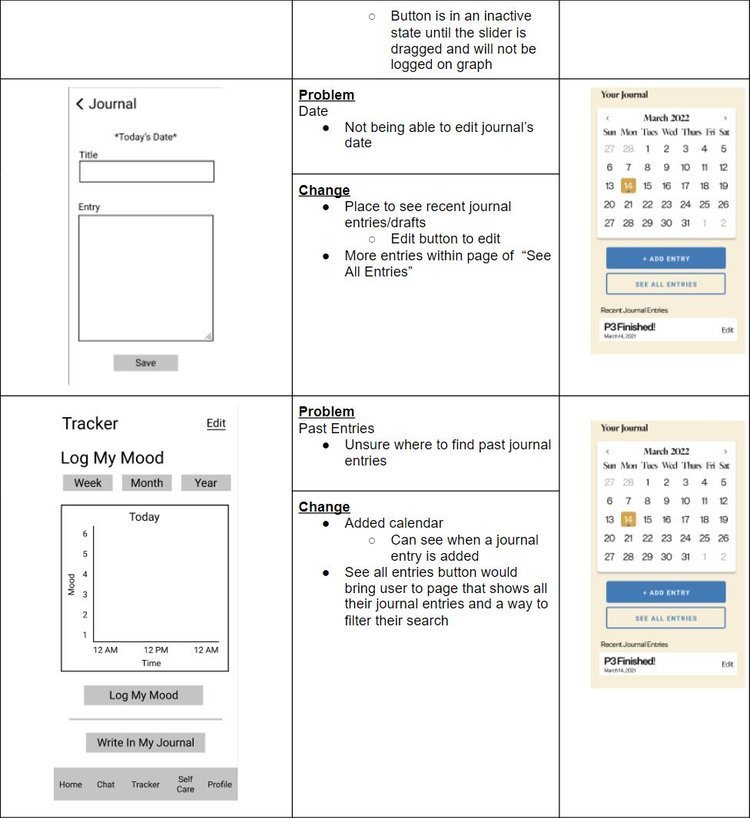Ginger App
Take Charge of Your Well-Being: Track Your Journey with Ginger
Ginger goes beyond emotional support by offering on-demand access to mental health professionals, including coaches, therapists, and psychiatrists. Their goal? Empowering users to manage anxiety, depression, sleep issues, and a variety of mental health challenges.
We all know self-care is important, but sometimes it's hard to see the progress you're making. That's why we created a way for you to easily track your moods and document your mental health journey with Ginger.
Role: UX Researcher, UI Designer
Hypothesis:
We believe that if users can track their moods over time and use the insights from the mood tracker, they will experience a positive change in their overall mental health.
Research Goals:
Conduct user interviews to understand users’ perception of the mood tracker’s impact on their mental well-being.
To analyze user feedback on perceived improvements in mental health.
To evaluate user perception of the mood tracker's role in promoting self-care.
To assess the clarity and usefulness of mood data visualizations.
User Interviews
Moderated Interviews
11 Participants Interviewed
Takeaway:
Many users practice self-reflection, taking time to document their thoughts and emotional well-being. These self-reflective users, demonstrate a commitment to mental health by utilizing various tools for tracking their progress, which includes mental health apps and journals.
Affinity Mapping
User Type 1: The Mental Health Beginner
This user wants to prioritize their mental health but feels overwhelmed by where to start.
Self-reflection can be challenging, and they'd prefer an approach that doesn't involve dwelling on emotions.
User Type 2: The Introspective Tracker
This user is naturally introspective and enjoys journaling or using other tools for self-reflection as part of their routine.
They're interested in a solution that complements their existing practices for documenting thoughts and feelings.
Problem Statements:
The Mental Health Beginner, wants a quick and effortless way to record moods and relevant context to identify trends and gain objective insights into their mental well-being.
The Introspective Tracker, needs a flexible solution that caters to their journaling and introspection style, allowing them to delve deeper into their thoughts and feelings.
LoFi to HiFi: What Happened?
1. Difficulty Recognizing Emotions:
Problem: Users struggled to understand the emotion selection process, particularly with the arrow buttons and the slider.
Solutions:
Replace the arrow buttons with clearer icons that represent each emotion.
Visually connect the slider to the emotions it affects, or display the corresponding emotion as the slider is adjusted.
Consider adding short labels or tooltips next to each emotion option for added clarity.
2. Misleading "Edit" Button:
Problem: Users were confused by the "Edit" button, expecting it to edit the mood graph instead of the page layout.
Solution:
Rename the button to something more specific, or placing edit in a more clear context.
Potentially add an icon that represents customization or settings next to the button.
3. Limited Journal Editing:
Problem: Users were unable to edit past journal entries or change the dates for their entries. They also couldn't easily access past entries.
Solutions:
Implement a clear "Edit" function within each journal entry to allow users to modify their content.
Allow users to tap on the date within the entry to open a calendar for date selection.
Create a dedicated "Journal" section within the app where users can easily see and access all their past entries.
High Fidelity Concept
Easy Access: Ensuring the CTA (Call to Action) for the tracker is readily available from the landing page is crucial. Users shouldn't have to search for it.
"See More" CTA: Using "See More" with the tracker makes sense, especially if there's limited space on the landing page. It creates intrigue and encourages users to explore further.
User Options: Highlighting that users can potentially see their past moods or add new entries through a blue button, which takes them a user friendly inputting system.
Real-time updates: Users can see their mood graph update immediately after inputting their ratings. This provides valuable reinforcement and helps users visualize their mood trends.
Optional journaling: Offering journaling as a toggle-able feature caters to different user preferences. Some users might prefer a quick mood logging experience, while others might appreciate the space for deeper reflection.
Clear integration: Mentioning that the journaling feature appears below the graph after enabling it sets a clear expectation for users.
Clear Navigation: Using a dedicated "Add Entry" button makes it clear how to access the journaling section.
Simple Interface: Providing a straightforward diary entry UI avoids overwhelming users and encourages quick journaling.
Visual Feedback: Showing users a calendar update with the submitted entry reinforces their action and helps them track their journaling progress.
Conclusion
Further testing provided valuable insights for improving our mood tracker app. While users appreciated the core functionality, we identified some areas for improvement:
Emotion Selection: 72% of users found the current method of choosing emotions using arrow buttons and a slider unclear.
Edit Button Confusion: 55% of users were unsure if the "Edit" button modified the graph or the page layout.
Limited Journal Editing: Users expressed a strong desire to edit past entries (all users) and access a dedicated journal section (80% of users).
Next Steps
Based on these findings, our team will prioritize the following improvements:
Revamp Emotion Selection: We will replace the confusing buttons and slider with clear icons and labels for each emotion.
Clarify "Edit" Button: We will rename the button to "Customize Page" and add a settings icon for better understanding.
Implement Journal Editing: We will add an "Edit" function within each entry and allow users to change the entry date.
Create a Dedicated Journal Section: We will develop a dedicated section within the app to display all past journal entries.
Takeaway
This research confirms a strong user interest in tracking their mental health (all users expressed interest). By addressing the identified usability issues and focusing on user needs, we can create a valuable tool that empowers users to take charge of their mental well-being.





